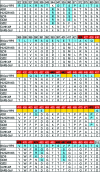Recombination, reservoirs, and the modular spike: mechanisms of coronavirus cross-species transmission
- PMID: 19906932
- PMCID: PMC2838128
- DOI: 10.1128/JVI.01394-09
Recombination, reservoirs, and the modular spike: mechanisms of coronavirus cross-species transmission
Abstract
Over the past 30 years, several cross-species transmission events, as well as changes in virus tropism, have mediated significant animal and human diseases. Most notable is severe acute respiratory syndrome (SARS), a lower respiratory tract disease of humans that was first reported in late 2002 in Guangdong Province, China. The disease, which quickly spread worldwide over a period of 4 months spanning late 2002 and early 2003, infected over 8,000 individuals and killed nearly 800 before it was successfully contained by aggressive public health intervention strategies. A coronavirus (SARS-CoV) was identified as the etiological agent of SARS, and initial assessments determined that the virus crossed to human hosts from zoonotic reservoirs, including bats, Himalayan palm civets (Paguma larvata), and raccoon dogs (Nyctereutes procyonoides), sold in exotic animal markets in Guangdong Province. In this review, we discuss the molecular mechanisms that govern coronavirus cross-species transmission both in vitro and in vivo, using the emergence of SARS-CoV as a model. We pay particular attention to how changes in the Spike attachment protein, both within and outside of the receptor binding domain, mediate the emergence of coronaviruses in new host populations.
Figures





References
-
- Alekseev, K. P., A. N. Vlasova, K. Jung, M. Hasoksuz, X. Zhang, R. Halpin, S. Wang, E. Ghedin, D. Spiro, and L. J. Saif. 2008. Bovine-like coronaviruses isolated from four species of captive wild ruminants are homologous to bovine coronaviruses, based on complete genomic sequences. J. Virol. 82:12422-12431. - PMC - PubMed
-
- Anonymous. 1999. Outbreak of Hendra-like virus—Malaysia and Singapore, 1998-1999. MMWR Morb. Mortal. Wkly. Rep. 48:265-269. - PubMed
-
- Anonymous. 1999. Update: outbreak of Nipah virus—Malaysia and Singapore, 1999. MMWR Morb. Mortal. Wkly. Rep. 48:335-337. - PubMed
Publication types
MeSH terms
Substances
Grants and funding
LinkOut - more resources
Full Text Sources
Other Literature Sources
Medical
Miscellaneous

